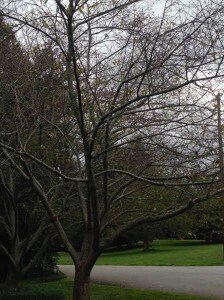 As I drove around the beautiful streets of Greenville one day, I couldn’t help but enjoy the old specimen trees that canopy over the streets and sidewalks throughout.
As I drove around the beautiful streets of Greenville one day, I couldn’t help but enjoy the old specimen trees that canopy over the streets and sidewalks throughout.
A series of large ornamental cherry trees quickly caught my eye… there were hardly any leaves on them! I knew that the trees would have promptly been removed if they were dead so my mind went to work thinking what could have caused this horrible thing to happen. Just a little while later I was on a client’s property and right there in the back was another naked Cherry tree!
I examined the few yellowed leaves that were left, which were all full of holes as if they had been chewed from the inside out. Japanese beetles quickly came to mind because they love to chew Cherry leaves. The only issue: the leaves don’t just fall off the tree after they’re chewed. I knew right then the signs were pointing to a fungus of some kind.
After a little research, I found that one of the many fungi that ornamental Cherry trees host is Blumeriella – the only one that causes a pretty rapid defoliation. Not only does it cause rapid defoliation, Blumeriella also reduces yields and winter readiness. When a tree looses its leaves in August, it will undergo a lot of stress; photosynthesis does not take place in the leaves so the roots of the tree begin to die back. Other processes important for growth and defense are short-circuited and the tree is left open to disease and insect attack.
Do you have a naked Cherry tree right now? Here are a few things you need to do:
- Make sure the leaves are raked and disposed of (they are full of spores that will re-infect the tree)
- Mulch the area under the tree crown to a depth of 2-3in.
- Give a good soaking once a week if no rain.
- Call Schneider Tree Care and have a Certified Arborist come out to evaluate your trees and provide a plan to keep them healthy.





